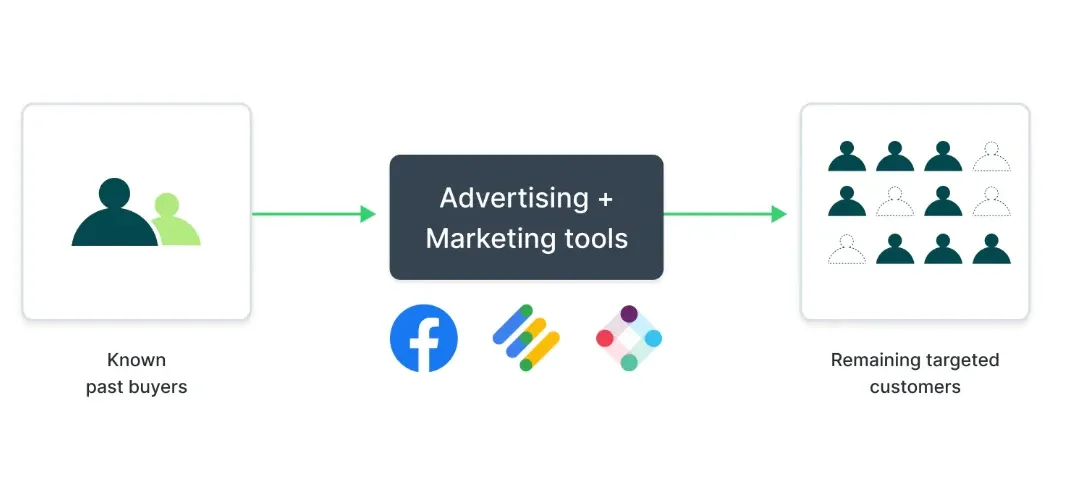In the rapidly evolving world of digital marketing, it’s not just about who you target – it’s also about who you choose not to target. Audience suppression, a technique often overlooked by marketers, is steadily gaining ground as a game-changer in enhancing ad efficiency and ROI.
According to a study by AdWeek, 37% of marketers have reported a substantial increase in campaign performance when implementing suppression strategies. But haphazard audience suppression can easily backfire. Without a clear methodology, you may suppress valuable segments and miss out on conversions. You need a strategic, nuanced approach to realize the benefits while avoiding pitfalls.
As industry expert Jenna Matthews notes, “Effective suppression isn’t just about excluding an audience – it’s about cultivating the right audience.” So, when should you leverage audience suppression, and how do you do it effectively? Dive in as we demystify the ins and outs of this pivotal marketing strategy.
Unraveling Audience Suppression
Not every marketing message resonates equally with every audience. This is where the strategic power of audience suppression shines.
Audience suppression, or exclusion, involves deliberately preventing specific groups of customers or prospects from seeing certain campaigns, ads, or messages. It allows you to fine-tune targeting to align messaging precisely with the needs and interests of the intended audience
For example, an e-commerce retailer promotes a 50% off sale for first-time app customers. Suppressing existing customers from seeing this campaign prevents confusion and maintains loyalty by not advertising special perks only for new users. Suppression optimizes the messaging specifically for the right segment in this case.
When aligned with campaign goals and audience insights, suppression can achieve several key objectives:
- Prevent Ad Fatigue: Seeing the same ad or campaign repeatedly eventually frustrates consumers, decreasing engagement over time. Strategically suppressing groups already overexposed to a message avoids this fatigue.
- Protect Existing Customers: Offers tailored specifically for prospects or new users often don’t apply or need clarification for your current customer base. Suppressing current customers from these campaigns prevents frustration and helps maintain loyalty.
- Optimize Ad Spend: Excluding audience segments with historically low intent or high bounce rates allows focus spending on higher-converting groups for a better return on ad spend. Purposeful suppression reduces wasted marketing dollars.
- Enhance Personalization: By suppressing groups unlikely to engage, you can craft messages tailored precisely to each target audience’s needs and interests for greater impact. Suppression improves personalization.
- Maintain Privacy & Compliance: Suppressing groups that have opted out from communication or fall under regulations aids legal compliance and upholds consumer privacy preferences.
When deployed strategically based on data insights, audience suppression allows for delivering the optimal message to the right customer groups. But indiscriminate, blanket suppression can easily backfire, blocking you from reaching qualified audiences. A nuanced, segmented approach is key.
Unraveling Audience Suppression
Steps for Audience Suppression
Executing effective audience suppression requires careful planning and disciplined execution. Follow these steps to maximize the strategic value of suppression:
Define Suppression Objectives
First, determine the goals you want to achieve through suppression. Common objectives include reducing ad fatigue, protecting high-value customer groups, improving personalization, optimizing ad spend, or boosting relevancy. Defined goals will guide your overall suppression strategy.
Segment Your Audience
Leverage first-party customer data to divide your audience into meaningful segments based on attributes like demographics, behaviors, interests, purchase history, campaign interactions, and other insights. Advanced segmentation identifies both high-intent groups to target and low-intent groups to consider for suppression.
Identify Suppression Targets
With audience segments defined, analyze them to determine which specific groups should be suppressed from which campaigns. For example, you may want to exclude existing subscribers from promotions aimed at new customers or suppress recent purchasers from repetitive retargeting ads.
Build Suppression Lists
Compile lists of unique identifiers like email addresses, cookies, or customer IDs that correspond to the audience groups earmarked for suppression. Structured lists ensure you can accurately exclude the right users at the platform level.
Choose Supporting Platforms
Select marketing tools and platforms with robust exclusion and suppression capabilities like email service providers, demand-side platforms, and customer data platforms. Most CRMs also allow for suppressing specific contacts.
Implement Suppression Lists
Ingest your suppression lists into the selected platforms. Exclusion workflows vary but often involve uploading CSVs or applying rule-based suppression filters. Tag management tools can also exclude defined users.
Test for Accuracy
Conduct small test sends or campaigns before full deployment to confirm the right users are being accurately suppressed without unintended exclusions. Preemptively catch any data issues.
Launch and Monitor Campaigns
With testing complete, launch your suppressed campaigns and initiatives. Continuously monitor performance and optimize based on insights uncovered through analysis and attribution.
Update Suppression Lists
Revisit exclusion lists routinely to add or remove audience segments as behaviors and priorities evolve over time. Keeping lists current ensures maximum relevance.
Audience suppression allows marketers to fine-tune messaging and avoid wasted ad spend. But basic suppression only scratches the surface of its strategic potential. So, let’s explore some high-impact applications.
Advanced Audience Suppression Tactics to Boost Campaign ROI
With customer intelligence from a unified data foundation, marketers can execute advanced suppression tactics to dramatically sharpen targeting and boost campaign ROI.
Suppress Regular Buyers from Branded Search
Many customers habitually search for brand names directly instead of typing the URL. Serving ads to these high-intent “lazy clickers” offers little value. A customer data platform (CDP) like Lifesight Connect can identify regular buyers and suppress them from paid branded searches. This protects their experience while focusing on prospects who need persuasion.
Example: An athletic apparel brand can use its CDP to identify buyers who have made 2+ purchases in the past 3 months. These repeat customers can be suppressed from paid search ads on branded keywords to avoid overspending.
Suppress Recent Buyers from Product Ads
Buyers don’t need product ads immediately after purchase. But basic always-on targeting often continues serving repetitive ads, annoying customers. A CDP allows suppressing recent buyers from product campaigns temporarily to avoid over-exposure. When the time is right, suppressed users can be re-engaged via tailored promotions.
Example: A consumer electronics retailer can suppress customers who have purchased a smart TV in the last 30 days from retargeting ads promoting that same smart TV model. This avoids annoying recent buyers with repetitive ads.
Suppress Existing Customers from Lookalike Audiences
Lookalike targeting aims to find new customers resembling your best ones. But many lookalike models inadvertently include existing customers too. Suppressing your customer base avoids wasted ad spend on those already loyal. Excluding existing customers also fine-tunes lookalike targeting purely for acquisition.
Example: A subscription service for customized vitamins can suppress its subscriber list from lookalike audiences modeled off their high-value subscribers. This refines targeting for new prospects who resemble existing subscribers.
Suppress Prospects from Sweepstakes Audiences
Sweepstakes attract new prospects by offering prizes for submitting contact information. But general lookalike targeting often exposes prospects already in your database too. Suppressing existing contacts increases sweepstakes efficiency by focusing exclusively on net-new prospect acquisition.
Example: An automotive brand running sweepstakes can suppress prospects already in their CRM database from the sweepstakes ads. This reduces wasted ad impressions and keeps the focus on net new lead generation.
Suppress Churned Customers
It’s impossible to fully prevent churn. But basic suppressing groups that have disengaged avoids wasting resources trying to reactivate them. A CDP’s predictive models help identify customers highly likely to churn for proactive suppression. Resources get redirected to high-lifetime-value customers.
Example: A SaaS platform can use predictive churn models in its CDP to identify at-risk customers with a high propensity to cancel service. These unstable customers can be suppressed from retention campaigns.
Send Fewer Impressions to Low-Value Customers
The 80/20 rule means 20% of customers drive 80% of revenue. Suppressing low-value groups from always-on campaigns focuses spend on your most valuable segments. CDP-powered analytics quantifies customer value to inform nuanced tiered suppression.
Example: A retailer can use their CDP to segment customers into value tiers. Low-value tiers can have lower campaign impression caps compared to high-value VIP segments that see higher caps.
Sophisticated suppression requires a CDP to connect data across channels for unified profiles reflecting true customer value. With holistic intelligence, suppression evolves into a scalpel for ultra-targeted messaging. Consumers see only relevant ads while ROI climbs.
CEO of Camelot Strategic Marketing & Media Sam Bloom said in an interview that advertising campaigns that work need to reach the right people at the right time and avoid reaching the same people twice through different media platforms.
With the help of a Customer Data Platform, you can swiftly locate, categorize, and suppress audiences that are not likely to respond to your marketing campaigns. These cutting-edge suppression techniques assist you in enhancing the reputation of your business, raising your return on investment, and eliminating superfluous ad expenditures.
Achieve strategic suppression at scale with Lifesight
To move beyond basic suppression, marketers need complete customer intelligence. Lifesight Connect provides the unified data foundation to power strategic exclusion across channels.
Connect ingests data enterprise-wide, resolving identities to construct unified customer records. This single view reveals hidden insights for segmentation and personalization.
Robust analytics within Connect quantify metrics like customer lifetime value and purchase propensity. Predictive models identify high-value customers versus churn risks. These insights inform a nuanced suppression strategy.
Seamlessly integrating with your martech stack, Connect activates audience data to suppress targeted segments across advertising, email, web experiences, and more. Suppression options include:
- Exclusion Lists – Upload specific identities for blanket suppression based on unique customer criteria. Keep high-intent groups like recent purchasers or loyal subscribers from seeing irrelevant ads.
- Algorithmic Audiences – Leverage Connect’s analytics to automatically suppress users matching churn, value, or propensity data models. Automatically exclude customers unlikely to convert.
- CRM Audiences – Build audiences in your CRM then sync to Connect for suppression across other channels. Keep prospects out of customer-only promotions.
- Custom Segment Syncing – Create dynamic segments in Connect based on behavior then sync these groups to your ad platform for suppression. Exclude recent site visitors from retargeting.
- Event-Based Triggers – Set up triggers to suppress users who complete key actions. Automatically remove purchasers from cart abandonment campaigns.
With Connect, audience data flows freely across tools through APIs and integrations. Ongoing profile enrichment within Connect allows for evolving suppression in step with changing customer needs. Suppressed groups receive only the messages most relevant to their current state. Touchpoint cadence aligns tightly with the lifecycle stage.
Strategic suppression is no longer a manual, siloed process. Connect provides the customer intelligence engine to personalize engagement through exclusion at the enterprise scale.
Postscript
In today’s crowded marketplace, strategic audience suppression is imperative for breakthrough results. Excluding specific groups from campaigns reduces waste and bolsters relevance.
With unified data as the foundation, tailored exclusion reaches its full potential. Customer data platforms consolidate cross-channel information into the holistic profiles required for nuanced suppression.
When leveraged strategically, suppression becomes a powerful instrument for next-level campaign performance. Wasted spending declines as relevance sharpens. Consumer fatigue gives way to sustained impact.
Now is the time to evolve suppression into an engine of growth and efficiency. Let Lifesight Connect provide customer intelligence to target audiences with surgical precision.
Discover how our Connect is helping leading brands execute suppression that transforms campaign ROI. Request a demo today!
You may also like
Essential resources for your success

















